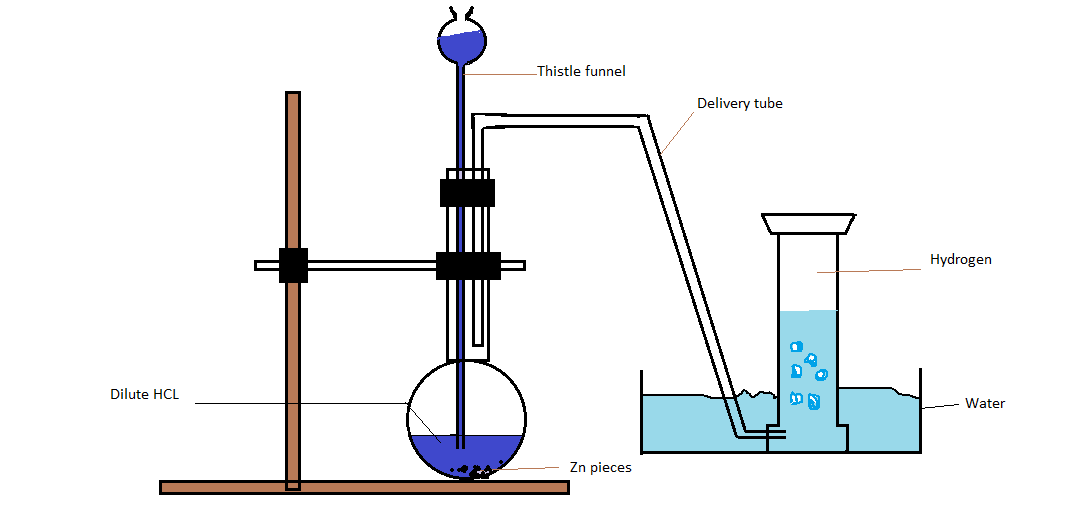
Explain the method of preparation of hydrogen gas in the laboratory with chemical equation and diagram?
Answer
587.4k+ views
Hint: The laboratory preparation of hydrogen gas involves the reaction of dilute hydrochloric acid on zinc pieces. We need a $500$ ml flask, a delivery tube, a test tube and a thistle funnel to perform this experiment.
Complete step by step solution:
> First of all we will take a few grams of zinc pieces and put them in the flask. Now add dilute Hydrochloric acid to zinc granules with the help of thistle funnel. After addition of dilute $HCl$ to the zinc pieces hydrogen gas will be produced automatically and this gas will be collected with the help of a delivery tube in a container full of water. Hence hydrogen gas is collected by the downward displacement of water.
Chemical equation: $Zn + 2HCl \to ZnC{l_2} + {H_2}$
> Uses and properties of hydrogen gas- Hydrogen gas is used in rocket fuel and in production of other compounds. It is used in welding, hydrogenation of fats and oils. Hydrogen is a diatomic gas. It is a tasteless, flammable and odourless substance .It can be stored in compressed form as a liquid. With the change of temperature, solubility of hydrogen gas in water does not affect it very much.

Laboratory method of preparation of hydrogen gas
Note: Hence hydrogen gas can be prepared in the laboratory with the help of conical flask ,fitted with the delivery tube. In the flask a few grams of granulated zinc are taken then dilute hydrochloric acid is added to the flask and liberated hydrogen gas is collected in an inverted test tube placed in water. Hydrogen gas obtained by this procedure contains different impurities like ${H_2}S,N{O_2},C{O_2}$ and moisture etc.
Complete step by step solution:
> First of all we will take a few grams of zinc pieces and put them in the flask. Now add dilute Hydrochloric acid to zinc granules with the help of thistle funnel. After addition of dilute $HCl$ to the zinc pieces hydrogen gas will be produced automatically and this gas will be collected with the help of a delivery tube in a container full of water. Hence hydrogen gas is collected by the downward displacement of water.
Chemical equation: $Zn + 2HCl \to ZnC{l_2} + {H_2}$
> Uses and properties of hydrogen gas- Hydrogen gas is used in rocket fuel and in production of other compounds. It is used in welding, hydrogenation of fats and oils. Hydrogen is a diatomic gas. It is a tasteless, flammable and odourless substance .It can be stored in compressed form as a liquid. With the change of temperature, solubility of hydrogen gas in water does not affect it very much.

Laboratory method of preparation of hydrogen gas
Note: Hence hydrogen gas can be prepared in the laboratory with the help of conical flask ,fitted with the delivery tube. In the flask a few grams of granulated zinc are taken then dilute hydrochloric acid is added to the flask and liberated hydrogen gas is collected in an inverted test tube placed in water. Hydrogen gas obtained by this procedure contains different impurities like ${H_2}S,N{O_2},C{O_2}$ and moisture etc.
Recently Updated Pages
Why are manures considered better than fertilizers class 11 biology CBSE

Find the coordinates of the midpoint of the line segment class 11 maths CBSE

Distinguish between static friction limiting friction class 11 physics CBSE

The Chairman of the constituent Assembly was A Jawaharlal class 11 social science CBSE

The first National Commission on Labour NCL submitted class 11 social science CBSE

Number of all subshell of n + l 7 is A 4 B 5 C 6 D class 11 chemistry CBSE

Trending doubts
Differentiate between an exothermic and an endothermic class 11 chemistry CBSE

10 examples of friction in our daily life

One Metric ton is equal to kg A 10000 B 1000 C 100 class 11 physics CBSE

Difference Between Prokaryotic Cells and Eukaryotic Cells

1 Quintal is equal to a 110 kg b 10 kg c 100kg d 1000 class 11 physics CBSE

State the laws of reflection of light




